Sailing the coast of Mexico
Sailing the coast of Mexico with friends
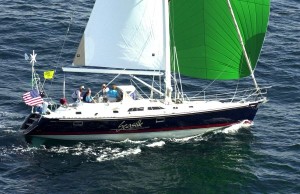
Who: Craig Blasingame & Sue Steven
Port: Coronado, California
10 October 2012 | Punta Abrejos - Campa En Medio anchorage
08 October 2012 | Enroute Turtle Bay to Punta Abrejos
07 October 2012 | Turtle Bay
06 October 2012 | Anchored at Cedros Island
04 October 2012 | Anchored at Cedros Island
03 October 2012 | Enroute to Cedros Island
02 October 2012 | Anchored at Bahia Santa Maria near Bahia San Quintin
01 October 2012 | Anchored at Bahia Santa Maria near Bahia San Quintin
30 September 2012 | Pacific Ocean off Totas Santos Island
29 September 2012 | Pacific Ocean off Totas Santos Island
28 September 2012
too many boats is a good thing
27 April 2013 | Isla Partida
Sue
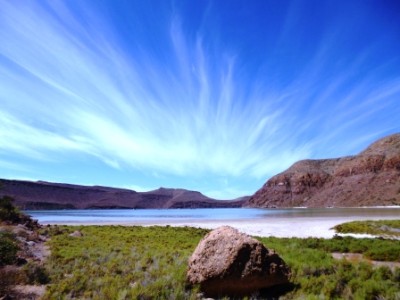
We left La Paz early on Saturday April 20th and settled ourselves in the main anchorage at Isla Partida, part of the Espirtu Santos Island National Park. The last time we were here two years ago, we were one of two boats. This week there were as many as 20 boats and never fewer than a dozen. Talking to some locals who live in La Paz, this is the most boats they have seen here in years. So the economy must be getting better somewhere.... for so many people to be cruising. In fact while we were in La Paz, we almost could not find an empty slip, everyone was in port to avoid the storm. Even the local fisherman has set up a secondary fish camp in this bay.
The islands are beautiful, but and the water a blue green like the carribbean, but the temperatures continued to hover around 61 degrees. This was ok wearing wetsuits while snorkeling the healthy reefs here, but made us less inclined to jump in and swim around the boat. We did use the stand up paddle board a bit along with the dingy to get to the best snorkeling spots.
The weather continued to be unpredictable. The wind would vary from nothing and glass calm water, to 20 knots at a moments notice, and this was all the while the forecast was for beautiful warm weather with 5 knots of wind. At least the wind kept the bugs at bay, which was the first time we have really been bothered by them.
We had a resident turtle near us. He must have been very old, because he was very large and had a large wizened head. We thought that perhaps he had lived long enough to be here when there were only sailing ships and none of these loud engines disturbing his reverie.
We have now returned to La Paz to enjoy some restaurants and local bicycling riding before heading onward to Cabo.
The islands are beautiful, but and the water a blue green like the carribbean, but the temperatures continued to hover around 61 degrees. This was ok wearing wetsuits while snorkeling the healthy reefs here, but made us less inclined to jump in and swim around the boat. We did use the stand up paddle board a bit along with the dingy to get to the best snorkeling spots.
The weather continued to be unpredictable. The wind would vary from nothing and glass calm water, to 20 knots at a moments notice, and this was all the while the forecast was for beautiful warm weather with 5 knots of wind. At least the wind kept the bugs at bay, which was the first time we have really been bothered by them.
We had a resident turtle near us. He must have been very old, because he was very large and had a large wizened head. We thought that perhaps he had lived long enough to be here when there were only sailing ships and none of these loud engines disturbing his reverie.
We have now returned to La Paz to enjoy some restaurants and local bicycling riding before heading onward to Cabo.
Candeleros with Julie and Bill
27 April 2013 | Candeleros Anchorage
Sue
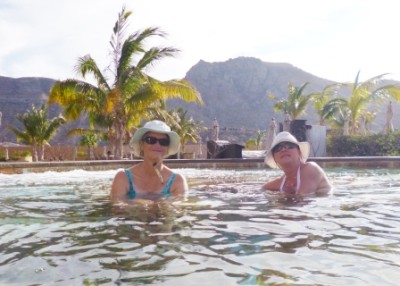
We left beautiful but windy San Juanico and headed straight for Candeleros Anchorage since our friends Julie and Bill were there. This anchorage is named for a series of three rocks near the peninsula that look like a candelabra. Mostly the three rocks are a danger to navigation, but fortunately we had good weather while passing by them.
We rode into the beach with Julie and Bill and enjoyed a drink and a swim at the beautiful resort that was mostly empty, but welcomed Yatistas.
We then headed for another boat from our Baja Ha Ha 2010 class, Double Dharma and enjoyed more drinks and snacks. Back on our on boat for dinner, we noticed the wind was picking up and the anchorage being quite small, we were all very close together, at risk for hitting one another as the wind went one way, and the current went the other. By bedtime, the wind was howling, so Craig and I decided to stand anchor watch all night. This was the first time we had to stand watches without the boat moving from point to point. Craig took the first four hours, and then I took the next four. At least we could read while on watch, so it wasn't too boring. Fortunately, we were fine, but we heard on the radio the next morning that one of the other boats dragged anchor and were heading towards the Candelabra rocks! His anchor alarm alerted him, and he and his now angry wife, reset the anchor at night, which is never a fun exercise.
We left that morning and stopped one night in San Francisco anchorage before going to La Paz for three days to wait out a storm. It was only bad one day, the port of La Paz was officially closed (no boats could go in or out), so we were glad to be sitting at a dock. We also needed fresh food. My creativity with canned food was challenging me.
We rode into the beach with Julie and Bill and enjoyed a drink and a swim at the beautiful resort that was mostly empty, but welcomed Yatistas.
We then headed for another boat from our Baja Ha Ha 2010 class, Double Dharma and enjoyed more drinks and snacks. Back on our on boat for dinner, we noticed the wind was picking up and the anchorage being quite small, we were all very close together, at risk for hitting one another as the wind went one way, and the current went the other. By bedtime, the wind was howling, so Craig and I decided to stand anchor watch all night. This was the first time we had to stand watches without the boat moving from point to point. Craig took the first four hours, and then I took the next four. At least we could read while on watch, so it wasn't too boring. Fortunately, we were fine, but we heard on the radio the next morning that one of the other boats dragged anchor and were heading towards the Candelabra rocks! His anchor alarm alerted him, and he and his now angry wife, reset the anchor at night, which is never a fun exercise.
We left that morning and stopped one night in San Francisco anchorage before going to La Paz for three days to wait out a storm. It was only bad one day, the port of La Paz was officially closed (no boats could go in or out), so we were glad to be sitting at a dock. We also needed fresh food. My creativity with canned food was challenging me.
Fossils and Tears
13 April 2013 | San Juanico (not Calleta as Sue told the net this morning, lol)
Craig
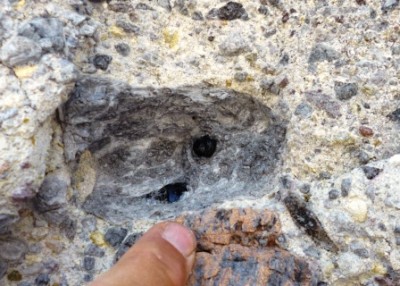
This was one of our worst anchorages ever. Winds from one direction and seas from the other. The poop-deck was getting pooped so often that Sue and I had to sleep in the forward cabin and listen the the wind howl through the rigging.
The morning brought relative calm and beautiful weather so we decided to explore some of the strange and wonderful geography that is San Juanico. A place that has everything from sandstone to fossil clam beds to lava flows with obsidian Apache Tears. We took our kayak ashore through crystal clear, green-blue water and began our walk at the "yatistas shrine"...a tree covered with signs and artifacts that other visiting yachts had left to commemorate their passage through here. One of the displays was a boat name written in obsidian nuggets. Just behind the tree, Craig spied a vein of shinning material and it turned out to be crystals (maybe gypsum). We collected a few of those, but were really interested in finding the source of the Apaches Tears.
We walked about 200 yards down the beach, collecting shells as we went and noticed that the geology had changed again. There was a gray cliff that looked knobby. On close inspection we discovered that the entire cliff was fossilized clam shells, some of a species that we had never seen in modern times. We took lots of pictures and collected a few shells that were loose at the bottom of the cliff. Craig, still looking for the obsidian moved west into the next geologic bed. The topography here is almost vertical bedding planes because of the severe geologic uplift, so you can go millions of years in time just by walking a hundred feet. There in the cliff was a grey volcanic flow with large grey blobs in it. The blobs contained the obsidian concretion (crystals) that the local people call Apache Tears. After we found them on the ground and in the cliff in sizes from pea to as big around as a dime, we noticed that the local beach was black like the black-sand beaches in Hawaii. The nodules are shaped like blueberries, but are shinny black. They are formed in a grey crystal matrix that was the fist-sized knobs that Craig first noticed in the rock.
Moving on down the beach in the kayak, we discovered another strange thing. A cliff with grey shale-like rock that had sea salt crystals on it. ONLY on the grey shale, not on the adjacent brown rock. Our supposition is that the shale absorbs salt spray and then excretes it at a rate that allows evaporation and deposit of the salt...any other speculations?
As we watched the sunset, we were amazed at the multitude of grebes, a small diving bird with bright red eyes. At home we may see one or two, here we see hundreds. They float on the surface and then all at once, dive below the surface as a group, resurfacing at almost the same time to resume their paddling.
A fun day was finished with a good wine and a pizza and hopefully a calm nights sleep before we leave tomorrow to begin our trip back to La Paz and ultimately home.
The morning brought relative calm and beautiful weather so we decided to explore some of the strange and wonderful geography that is San Juanico. A place that has everything from sandstone to fossil clam beds to lava flows with obsidian Apache Tears. We took our kayak ashore through crystal clear, green-blue water and began our walk at the "yatistas shrine"...a tree covered with signs and artifacts that other visiting yachts had left to commemorate their passage through here. One of the displays was a boat name written in obsidian nuggets. Just behind the tree, Craig spied a vein of shinning material and it turned out to be crystals (maybe gypsum). We collected a few of those, but were really interested in finding the source of the Apaches Tears.
We walked about 200 yards down the beach, collecting shells as we went and noticed that the geology had changed again. There was a gray cliff that looked knobby. On close inspection we discovered that the entire cliff was fossilized clam shells, some of a species that we had never seen in modern times. We took lots of pictures and collected a few shells that were loose at the bottom of the cliff. Craig, still looking for the obsidian moved west into the next geologic bed. The topography here is almost vertical bedding planes because of the severe geologic uplift, so you can go millions of years in time just by walking a hundred feet. There in the cliff was a grey volcanic flow with large grey blobs in it. The blobs contained the obsidian concretion (crystals) that the local people call Apache Tears. After we found them on the ground and in the cliff in sizes from pea to as big around as a dime, we noticed that the local beach was black like the black-sand beaches in Hawaii. The nodules are shaped like blueberries, but are shinny black. They are formed in a grey crystal matrix that was the fist-sized knobs that Craig first noticed in the rock.
Moving on down the beach in the kayak, we discovered another strange thing. A cliff with grey shale-like rock that had sea salt crystals on it. ONLY on the grey shale, not on the adjacent brown rock. Our supposition is that the shale absorbs salt spray and then excretes it at a rate that allows evaporation and deposit of the salt...any other speculations?
As we watched the sunset, we were amazed at the multitude of grebes, a small diving bird with bright red eyes. At home we may see one or two, here we see hundreds. They float on the surface and then all at once, dive below the surface as a group, resurfacing at almost the same time to resume their paddling.
A fun day was finished with a good wine and a pizza and hopefully a calm nights sleep before we leave tomorrow to begin our trip back to La Paz and ultimately home.
Here there and everywhere
11 April 2013 | Puerto Ballendra on Isla Carmen
Craig
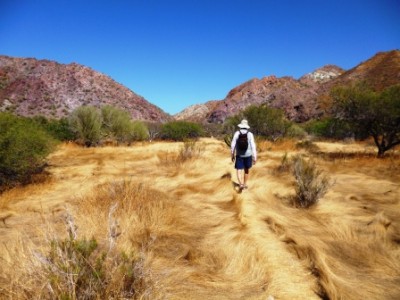
We left beautiful Aqua Verde early Monday morning bound for Puerto Escondido. Craig was able to sail for the first couple of hours and then the wind became so strong (25-30 knots on the beam) that we needed to turn downwind just to get the jib in and reef the main to 50%. Even with that, it was a rough ride with speeds approaching 7.5 knots. By the time arrived at the inside passage around Punta Candeleros, it had calmed to less than 10 knots and the rest of the trip was uneventful.
Upon arriving at Escondido we decided to stay out in the "waiting room" rather than trying to navigate the shallow channel into the mooring area of "hidden harbor". Sadly, the "waiting room" has become more of a "living room". Almost all of the available space is taken up by 'private' moorings used by residents, some of whom have lived there for over 20 years. We found a tight spot and anchored, but after several hours the wind shifted and we were very close to another sailboat to port and an unoccupied mooring to stern. One of the residents kindly suggested that we move over under the "bluffs" where there was another, larger, sailboat and plenty of room. We did this and found good anchorage in sand, but a bit rolly and somewhat close to shore for long term comfort. We only stayed the one night and then moved across the 8 miles to Puerto Ballandra.
Ballandra is a very nice anchorage with lots of room and good protection from north breezes and most of the SE swell. Isla Carmen was, until recently, the location of a large sea salt production operation on the other side of the island from Balandra. Ballandra Bay has steep cliffs rising from all sides except due east where there is a salt marsh and a dry river bed leading over the gap in the mountains to the salt ponds. Sue and I walked about 1/2 the distance across the gap, but were not yet able to see over and down onto the salt flats. Along the way there was evidence of the wet fall they had here last year in the form of long marsh grasses that when dried up in the wind, swirl into tufts that look like a weird hairdo part on a giant. Wednesday we took the kayak and explored one of the small beaches to the north of our anchorage. There, we discovered an entire hillside of fossil pipe coral and other fossilized shells. This must be "recent" deposits (by geological standards) since the fossil shells closely resemble the shells we would pick up today with the exception that we have seen none of the chimney-shaped pipe coral on the MX coasts. So either uplift or sea level rise in the "recent" past, take your pick. We did collect a couple of the "button" worm-shells that Montyne liked to collect in the fossil beds. We've not been swimming here because there are visible jellies floating around the boat and the days have been colder than before. In fact, Sue is sitting wrapped up in a blanket as I write this.
Tomorrow we are planning to move on to Calenta de San Juanico. We expect this to be our northern-most stop and we plan to stay there several days before beginning a slow trip back to La Paz.
Upon arriving at Escondido we decided to stay out in the "waiting room" rather than trying to navigate the shallow channel into the mooring area of "hidden harbor". Sadly, the "waiting room" has become more of a "living room". Almost all of the available space is taken up by 'private' moorings used by residents, some of whom have lived there for over 20 years. We found a tight spot and anchored, but after several hours the wind shifted and we were very close to another sailboat to port and an unoccupied mooring to stern. One of the residents kindly suggested that we move over under the "bluffs" where there was another, larger, sailboat and plenty of room. We did this and found good anchorage in sand, but a bit rolly and somewhat close to shore for long term comfort. We only stayed the one night and then moved across the 8 miles to Puerto Ballandra.
Ballandra is a very nice anchorage with lots of room and good protection from north breezes and most of the SE swell. Isla Carmen was, until recently, the location of a large sea salt production operation on the other side of the island from Balandra. Ballandra Bay has steep cliffs rising from all sides except due east where there is a salt marsh and a dry river bed leading over the gap in the mountains to the salt ponds. Sue and I walked about 1/2 the distance across the gap, but were not yet able to see over and down onto the salt flats. Along the way there was evidence of the wet fall they had here last year in the form of long marsh grasses that when dried up in the wind, swirl into tufts that look like a weird hairdo part on a giant. Wednesday we took the kayak and explored one of the small beaches to the north of our anchorage. There, we discovered an entire hillside of fossil pipe coral and other fossilized shells. This must be "recent" deposits (by geological standards) since the fossil shells closely resemble the shells we would pick up today with the exception that we have seen none of the chimney-shaped pipe coral on the MX coasts. So either uplift or sea level rise in the "recent" past, take your pick. We did collect a couple of the "button" worm-shells that Montyne liked to collect in the fossil beds. We've not been swimming here because there are visible jellies floating around the boat and the days have been colder than before. In fact, Sue is sitting wrapped up in a blanket as I write this.
Tomorrow we are planning to move on to Calenta de San Juanico. We expect this to be our northern-most stop and we plan to stay there several days before beginning a slow trip back to La Paz.
From here on it's new ground
05 April 2013 | Aqua Verde
Craig
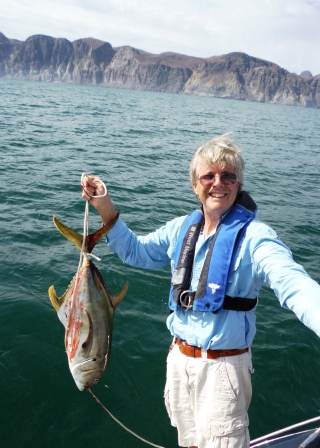
Aqua Verde is one of the places on Earth where everyone should come once in their life and I have been lucky enough to come here twice. Sadly, if everyone were to come here it would not retain its natural charm long. Aqua Verde (literally turquoise water) was our northern most stop in the Sea of Cortez during our 2010-11 visit. It is hard to describe how beautiful it is here and how much wildlife abounds in the presence of scant inhabitation. Then there is El Solitaria, a rock spire that towers over the entrance to the small bay. The spire is white (mostly from bird guano) and that makes it glow in the sunset and sunrise. It rises out of the water from 50 feet deep and soars to over 150 feet. Yet, it is so small in diameter that snorkelers can easily traverse its circumference in a single outing.
When we came here in 2010, we could only stay a single day because there was a storm brewing from the north and if forced us all the way back to San Francisco where we sat and watched the waves pass for three days before we could even go ashore there. That storm was bad enough that they had to close the harbor at La Paz for several days. This time, we expect to enjoy good weather and hope to stay a couple of days before we continue our adventure on into unexplored (at least by us) regions of the Gulf of California.
Craig caught a 20# yellow-fin tuna this morning on our way here and we are getting ready to cook a small portion of that bad boy up for dinner. He caught it on the same diving romalla lure that he has caught all but one of the fish he has landed this trip. Don't know what we will do if that lure is lost and it almost was. On the trip north from Z- town, we snagged a fisherman's long line and reeled out almost all of our line before we could get the boat stopped. Luckily, the fisherman was on hand in his panga and came over and cut the line so I could retrieve it. Even more fortunate and surprising, the fisherman caught up to us and returned my precious lure. I LOVE MEXICO.
When we came here in 2010, we could only stay a single day because there was a storm brewing from the north and if forced us all the way back to San Francisco where we sat and watched the waves pass for three days before we could even go ashore there. That storm was bad enough that they had to close the harbor at La Paz for several days. This time, we expect to enjoy good weather and hope to stay a couple of days before we continue our adventure on into unexplored (at least by us) regions of the Gulf of California.
Craig caught a 20# yellow-fin tuna this morning on our way here and we are getting ready to cook a small portion of that bad boy up for dinner. He caught it on the same diving romalla lure that he has caught all but one of the fish he has landed this trip. Don't know what we will do if that lure is lost and it almost was. On the trip north from Z- town, we snagged a fisherman's long line and reeled out almost all of our line before we could get the boat stopped. Luckily, the fisherman was on hand in his panga and came over and cut the line so I could retrieve it. Even more fortunate and surprising, the fisherman caught up to us and returned my precious lure. I LOVE MEXICO.
Adventures in the Sea of Cortez-- part 1
03 April 2013 | San Francisco Island
Craig
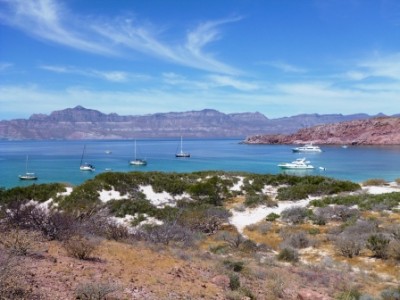
We left La Paz yesterday in beautiful weather and motor-sailed 35 nm to San Francisco. This island is one of my favorite anchorages in all of Mexico. Crystal clear blue and green waters in a new-moon shaped semicircle overlooked by rugged red cliffs. We eagerly went ashore today: Sue to hunt for shells and Craig to hunt for agates. San Francisco is known for its blue-green agates and Sue had discovered a prime vein last time we were here. Today we went right to it and found 10 large ones and numerous small samples. Hopefully, someday Craig will take the time to polish some of the better ones for display. [The ones from the first trip are still sitting in a bag :
| Vessel Name: | SEASILK |
| Vessel Make/Model: | HYLAS 46 |
| Hailing Port: | Coronado, California |
| Crew: | Craig Blasingame & Sue Steven |
Gallery not available
Sailing the coast of Mexico with friends

Who: Craig Blasingame & Sue Steven
Port: Coronado, California